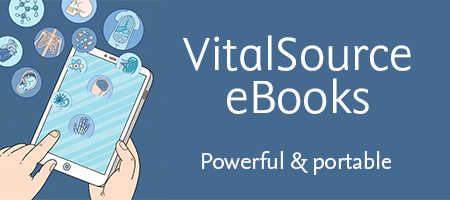Let Canada’s #1 pharmacology text guide you in mastering the complicated world of nursing pharmacology! Now in its fifth edition, Lilley’s Pharmacology for Canadian Health Care Practice covers all the key pharmacology content needed by today’s Canadian nurses. Known for its vibrant design, abundance of visuals, and wealth of helpful feature boxes, this engaging text brings important pharmacology concepts to life. The book’s popular and unique key drug approach focuses on the drug information you need to know to safely and effectively administer drugs. Providing exam preparation and insightful learning strategies, this complete (and proven) pharmacology text helps you succeed in school, clinicals, and professional practice.
Key Features
- UPDATED! Thoroughly updated drug content reflects the latest Health Canada drug approvals, withdrawals, and therapeutic uses, as well as corresponding updated nursing content.
- UPDATED! Coverage of current top-of-mind topics includes the new 2023 COPD definition, new asthma recommendations and guidelines, the impact of COVID-19 on respiratory diseases and management, pharmacology as it pertains to palliative care, updated marijuana information for both medical and recreational purposes, issues surrounding the use and misuse of fentanyl and the take-home distribution of naloxone kits used to tackle the growing fentanyl crises, and more.
- NEW! The latest Canadian statistics, research, legislation, regulations, and clinical practice guidelines are incorporated throughout the text as well as content reflecting the 2017 CNA Code of Ethics, updated references, and more.
- Comprehensive visual program incorporates diagrams, graphs, charts, and photos throughout the text to accompany difficult concepts and theories and help facilitate learning.
- Consistent and colourful reader-friendly format utilizes summary tables and a practical body systems organization to integrate pharmacology content with what you are learning in medical-surgical and adult health nursing courses.
- Practice questions for the Next Generation NCLEX® are included on the companion Evolve website.
- Popular key drug approach focuses on need-to-know content for safe clinical practice, using a streamlined approach to drug indications and emphasizing only the most common or serious adverse effects.
- Focus on prioritization connects prioritized nursing diagnoses to a corresponding prioritization of goals and outcomes.
- Case studies reflect real-world scenarios and the diverse Canadian population.
- Incorporation of the Truth and Reconciliation Commission of Canada’s Calls to Action covers Indigenous health and healing practices, an explanation of the Indigenous medicine wheel, and alternative medicinal interventions.
- Examination review questions help you more thoroughly prepare for credentialling exams.
- Cartoon-illustrated study tips on Evolve cover study, time management, and test-taking tips.
- Wealth of student-friendly learning aids includes approachable text elements such as:
- Case studies throughout the text that help bring patients to life
- Drug profiles highlighting specific information on commonly used agents
- More than 250 full-colour photos and illustrations showing how drugs work in the body and how to administer medications safely and effectively
- Pharmacokinetics tables that include "Elimination Half-Life" information for each drug profile
- Dosages tables providing instant access to dosages, routes, and indications for individual drugs
- Patient Teaching tips outlining useful patient information specific to each drug group
- Evidence in Practice boxes featuring current research and findings relevant to nursing pharmacology
- Lab Values Related to Drug Therapy summary boxes covering therapeutic levels of various drugs
- Preventing Medication Errors boxes reinforcing concepts and relating them to specific common errors that occur in nursing pharmacology
- Ethnocultural Implications boxes discussing differences to expect among cultural or ethnic groups
- Natural Health Products boxes providing an Overview, Common Uses, Adverse Effects, Potential Drug Interactions, and Contraindications for popular herbal therapies
- Special Populations Considerations boxes highlighting critical points related to drug therapy in children, adolescents, women and older adult patients
- Legal and Ethical Principles boxes promoting awareness of liability issues and proper professional conduct
- Pharmacokinetic Bridge to Nursing Practice covering topics such as heart failure, women’s health issues, iron, and monitoring renal function
- Key points summarizing the most important pharmacology and nursing content in each chapter
- Examination review questions in every chapter
Author Information
By Kara Sealock, RN, BN, MEd, EdD, Professor, Faculty of Nursing, University of Calgary ,Calgary, Alberta, Canada and Cydnee Seneviratne, RN, BScN, MN, PhD, University of Calgary, Faculty of Nursing
Calgary, Alberta
About the Authors
Reviewers
Preface
Acknowledgements
PART 1 Pharmacology Basics
1 Nursing Practice in Canada and Drug Therapy
Overview
Assessment
Analysis of Data
Nursing Diagnoses
Planning
Implementation
Evaluation
Evidence-Informed Practice
2 Pharmacological Principles
Overview
Pharmaceutics
Pharmacokinetics
Pharmacodynamics
Pharmacotherapeutics
Pharmacognosy
Pharmacoeconomics
Toxicology
Summary
3 Legal and Ethical Considerations
Legal Considerations
New Drug Development
Health Canada Drug Approval Process
Legal Nursing Considerations and Drug Therapy
Ethical Considerations
4 Patient-Focused Considerations
Population-Based Considerations and Drug
Therapy
Assessment
Nursing Diagnoses: Age-Related
Planning
Implementation
Evaluation
Nursing Diagnoses: Ethnocultural
Planning
Implementation
Evaluation
5 Gene Therapy and Pharmacogenomics
Overview
Discovery, Structure, and Function of DNA
Gene Therapy
Pharmacogenetics and Pharmacogenomics
Application of Genetic Principles in Drug Therapy
and the Nursing Process
6 Medication Errors: Preventing and Responding
Overview
Issues Contributing to Errors
Preventing, Responding to, Reporting, and
Documenting Medication Errors: A Nursing
Perspective
Other Ethical Issues
Summary
7 Patient Education and Drug Therapy
Overview
Assessment
Nursing Diagnoses
Planning
Implementation
Evaluation
Summary
8 Over-the-Counter Drugs and Natural Health Products
Over-the-Counter Drugs
Natural Health Products
Assessment
Nursing Diagnoses
Planning
Implementation
Evaluation
9 Vitamins and Minerals
Overview
Fat-Soluble Vitamins
Water-Soluble Vitamins
Minerals
Assessment
Nursing Diagnoses
Planning
Implementation
Evaluation
10 Principles of Drug Administration
Preparing for Drug Administration
Enteral Drugs
Parenteral Drugs
Topical Drugs
PART 2 Drugs Affecting the Central Nervous System
11 Analgesic Drugs
Overview
Opioid Drugs
Nonopioid and Miscellaneous Analgesics
Assessment
Nursing Diagnoses
Planning
Implementation
Evaluation
12 General and Local Anaesthetics
Anaesthetics
Neuromuscular Blocking Drugs
Pharmacokinetic Bridge to Nursing Practice
Assessment
Nursing Diagnoses
Planning
Implementation
Evaluation
13 Central Nervous System Depressants and Muscle
Relaxants
Overview
Benzodiazepines and Miscellaneous Hypnotic
Drugs
Barbiturates
Over-the-Counter Hypnotics
Muscle Relaxants
Assessment
Nursing Diagnoses
Planning
Implementation
14 Central Nervous System Stimulants and Related Drugs
Overview
Drugs for Attention-Deficit/Hyperactivity Disorder
and Narcolepsy
Anorexiants
Antimigraine Drugs
Analeptics
Assessment
Nursing Diagnoses
Planning
Implementation
Evaluation
15 Antiepileptic Drugs
Epilepsy
Antiepileptic Drugs
Assessment
Nursing Diagnoses
Planning
Implementation
Evaluation
16 Antiparkinsonian Drugs
Parkinson’s Disease
Direct-Acting Dopaminergic Drugs
Indirect-Acting Dopaminergic Drugs
Anticholinergic Therapy
Assessment
Nursing Diagnoses
Planning
Implementation
Evaluation
17 Psychotherapeutic Drugs
Overview
Overview of Mental Health Disorders
Anxiolytic Drugs
Mood-Stabilizing Drugs
Antidepressant Drugs
Antipsychotic Drugs
Assessment
Nursing Diagnoses
Planning
Implementation
18 Substance Use Disorder
Overview
Opioids
Stimulants
Depressants
Alcohol
Nicotine
Assessment
Nursing Diagnoses
Planning
Implementation
Evaluation
PART 3 Drugs Affecting the Autonomic Nervous
System
19 Adrenergic Drugs
Overview
Adrenergic Drugs
Assessment
Nursing Diagnoses
Planning
Implementation
Evaluation
20 Adrenergic-Blocking Drugs
Overview
Alpha Blocker
Beta Blockers
Assessment
Nursing Diagnoses
Planning
Implementation
Evaluation
21 Cholinergic Drugs
Parasympathetic Nervous System
Cholinergic Drugs
Assessment
Nursing Diagnoses
Planning
Implementation
Evaluation
22 Cholinergic-Blocking Drugs
Overview
Cholinergic-Blocking Drugs
Assessment
Nursing Diagnoses
Planning
Implementation
Evaluation
PART 4 Drugs Affecting the Cardiovascular and
Renal System
23 Antihypertensive Drugs
Overview
Additional Adrenergic Drugs
Angiotensin-Converting Enzyme Inhibitors
Angiotensin II Receptor Blockers
Calcium Channel Blockers
Vasodilators
Assessment
Nursing Diagnoses
Planning
Implementation
Evaluation
24 Antianginal Drugs
Overview
Antianginal Drugs
Determining Drug Therapy
Assessment
Nursing Diagnoses
Planning
Implementation
Evaluation
25 Heart Failure Drugs
Overview
First-Line Drug Therapy
Additional Heart Failure Drugs
Assessment
Nursing Diagnoses
Planning
Implementation
Evaluation
26 Diuretic Drugs
Overview
Diuretic Drugs
Carbonic Anhydrase Inhibitors
Loop Diuretics
Osmotic Diuretics
Potassium-Sparing Diuretics
Thiazides and Thiazide-Like Diuretics
Assessment
Nursing Diagnoses
Planning
Implementation
Evaluation
27 Antidysrhythmic Drugs
Dysrhythmias and Normal Cardiac
Electrophysiology
Antidysrhythmic Drugs
Assessment
Nursing Diagnoses
Planning
Implementation
Evaluation
28 Coagulation Modifier Drugs
Overview
Anticoagulants
Antiplatelet Drugs
Thrombolytic Drugs
Antifibrinolytic Drugs
Nursing Process
Assessment
Nursing Diagnoses
Planning
Implementation
Evaluation
29 Antilipemic Drugs
Overview
Lipids and Lipid Abnormalities
Coronary Artery Disease
Antilipemic Drugs and Dyslipidemia Treatment
Guidelines
Miscellaneous Lipid-Lowering Agents
Assessment
Nursing Diagnoses
Planning
Implementation
Evaluation
30 Fluids and Electrolytes
Physiology of Fluid Balance
Application of Solutions and Blood Products
Physiology of Electrolyte Balance
Assessment
Nursing Diagnoses
Planning
Implementation
Evaluation
PART 5 Drugs Affecting the Endocrine System
31 Pituitary Drugs
Endocrine System
Pituitary Drugs
Assessment
Nursing Diagnoses
Planning
Implementation
Evaluation
32 Thyroid and Antithyroid Drugs
Overview
Thyroid Replacement
Antithyroid Drugs
Assessment
Nursing Diagnoses
Planning
Implementation
Evaluation
33 Antidiabetic Drugs
Overview of the Pancreas
Diabetes
Exogenous Insulins
Oral Antihyperglycemic Drugs
Injectable Antihyperglycemic Drugs
Glucose-Elevating Drugs
Pharmacokinetic Bridge to Nursing Practice
Assessment
Nursing Diagnoses
Planning
Implementation
Evaluation
34 Adrenal Drugs
Adrenal System
Adrenal Drugs
Assessment
Nursing Diagnoses
Planning
Implementation
Evaluation
35 Women’s Health Drugs
Overview of Female Reproductive Functions
Estrogens
Progestins
Selective Progesterone Receptor Modulator
Contraceptive Drugs
Drugs for Osteoporosis
Fertility Drugs
Drugs for Uterine Stimulation
Miscellaneous Drugs
Assessment
Nursing Diagnoses
Planning
Implementation
Evaluation
36 Men’s Health Drugs
Overview of the Male Reproductive System
Androgens and Other Miscellaneous Drugs
Assessment
Nursing Diagnoses
Planning
Implementation
Evaluation
PART 6 Drugs Affecting the Respiratory System
37 Antihistamines
Expectorants
Overview of Cold Medications
Antihistamines
Decongestants
Antitussives
Expectorants
Assessment
Nursing Diagnoses
Planning
Implementation
Evaluation
38 Respiratory Drugs
Overview
Diseases of the Respiratory System
Bronchodilators
Nonbronchodilating Respiratory Drugs
Assessment
Nursing Diagnoses
Planning
Implementation
Evaluation
PART 7 Drugs Affecting the Gastrointestinal
System and Nutrition
39 Acid-Controlling Drugs
Overview
Antacids
H2 Antagonists
Proton Pump Inhibitors
Miscellaneous Acid-Controlling Drugs
Assessment
Nursing Diagnoses
Planning
Implementation
Evaluation
40 Antidiarrheal Drugs and Laxatives
Overview
Antidiarrheals
Laxatives
Assessment
Nursing Diagnoses
Planning
Implementation
Evaluation
41 Antiemetic and Antinausea Drugs
Nausea and Vomiting
Antiemetic and Antinausea Drugs
Assessment
Nursing Diagnoses
Planning
Implementation
Evaluation
42 Nutritional Supplements
Overview
Enteral Nutrition
Total Parenteral Nutrition
Assessment
Nursing Diagnoses
Planning
Implementation
Evaluation
PART 8 Anti-Infective and Anti-Inflammatory Drugs
43 Antibiotics Part 1: Sulfonamides, Penicillins,
Cephalosporins, Macrolides, and Tetracyclines
Microbial Infection
General Principles of Antibiotic Therapy
Sulfonamides
Beta-Lactam Antibiotics
Macrolides
Tetracyclines
Assessment
Nursing Diagnoses
Planning
Implementation
Evaluation
44 Antibiotics Part 2: Aminoglycosides, Fluoroquinolones,
and Other Drugs
Overview
Aminoglycosides
Quinolones
Assessment
Nursing Diagnoses
Planning
Implementation
Evaluation
45 Antiviral Drugs
Overview
Herpes Simplex Virus and Varicella-Zoster Virus
Infection
Other Viral Illnesses and Coronavirus
Antivirals
HIV Infection and AIDS
Antiretroviral Therapy for Patients Living with HIV
and AIDS
Assessment
Nursing Diagnoses
Planning
Implementation
Evaluation
46 Antitubercular Drugs
Tuberculosis
Antitubercular Drugs
Assessment
Nursing Diagnoses
Planning
Implementation
Evaluation
47 Antifungal Drugs
Fungal Infections
Antifungal Drugs
Assessment
Nursing Diagnoses
Planning
Implementation
Evaluation
48 Antimalarial, Antiprotozoal, and Anthelmintic Drugs
Overview
Malaria
Antimalarial Drugs
Protozoal Infections and Nonmalarial Antiprotozoal
Drugs
Helminthic Infections and Anthelmintic Drugs
Assessment
Nursing Diagnoses
Planning
Implementation
Evaluation
49 Anti-Inflammatory and Antigout Drugs
Overview
Anti-Inflammatory and Antigout Drugs
Assessment
Nursing Diagnoses
Planning
Implementation
Evaluation
PART 9 Immune and Biological Modifiers and
Chemotherapeutic Drugs
50 Immunosuppressant Drugs
Immune System
Immunosuppressant Drugs
Assessment
Nursing Diagnoses
Planning
Implementation
Evaluation
51 Immunizing Drugs and Pandemic Preparedness
Immunity and Immunization
Immunizing Drugs
Pandemic Preparedness and Response
Assessment
Nursing Diagnoses
Planning
Implementation
Evaluation
52 Antineoplastic Drugs Part 1: Cancer Overview and Cell
Cycle–Specific Drugs
Overview of Cancer
Drug Therapy Overview
Antimetabolites
Mitotic Inhibitors
Topoisomerase Inhibitors
Antineoplastic Enzymes
Assessment
Nursing Diagnoses
Planning
Implementation
Evaluation
53 Antineoplastic Drugs Part 2: Cell Cycle–Nonspecific and
Miscellaneous Drugs
Cell Cycle–Nonspecific Antineoplastic Drugs
Hormonal and Radiopharmaceutical
Antineoplastics
Assessment
Nursing Diagnoses
Planning
Implementation
Evaluation
54 Biological Response–Modifying Drugs and Antirheumatic
Drugs
Overview
Hematopoietic Drugs
Immunomodulators
Rheumatoid Arthritis
Assessment
Nursing Diagnoses
Planning
Implementation
Evaluation
PART 10 Miscellaneous Therapeutics:
Hematological, Ophthalmic, and Otic Drugs
55 Anemia Drugs
Overview
Erythropoiesis-Stimulating Agents
Iron
Folic Acid
Other Anemia Drugs
Assessment
Nursing Diagnoses
Planning
Implementation
Evaluation
56 Dermatological Drugs
Skin Anatomy and Physiology
Antimicrobials
Other uses for Dermatological Drugs
Wound Care Drugs
Assessment
Nursing Diagnoses
Planning
Implementation
Evaluation
57 Ophthalmic Drugs
Overview of Ocular Anatomy
and Physiology
Treatment of Eye Disorders
Antiglaucoma Drugs
Antimicrobial Drugs
Anti-Inflammatory Drugs
Topical Anaesthetics
Diagnostic and Antiallergic Drugs
Assessment
Nursing Diagnoses
Planning
Implementation
Evaluation
58 Otic Drugs
Overview of Ear Anatomy and Ear Disorders
Treatment of Ear Disorders
Assessment
Nursing Diagnoses
Planning
Implementation
Evaluation
Appendix A: Pharmaceutical Abbreviations
Appendix B: Laboratory Reference Values
Answers to Review Questions
Index of Glossary Terms
Drug Index
General Index













